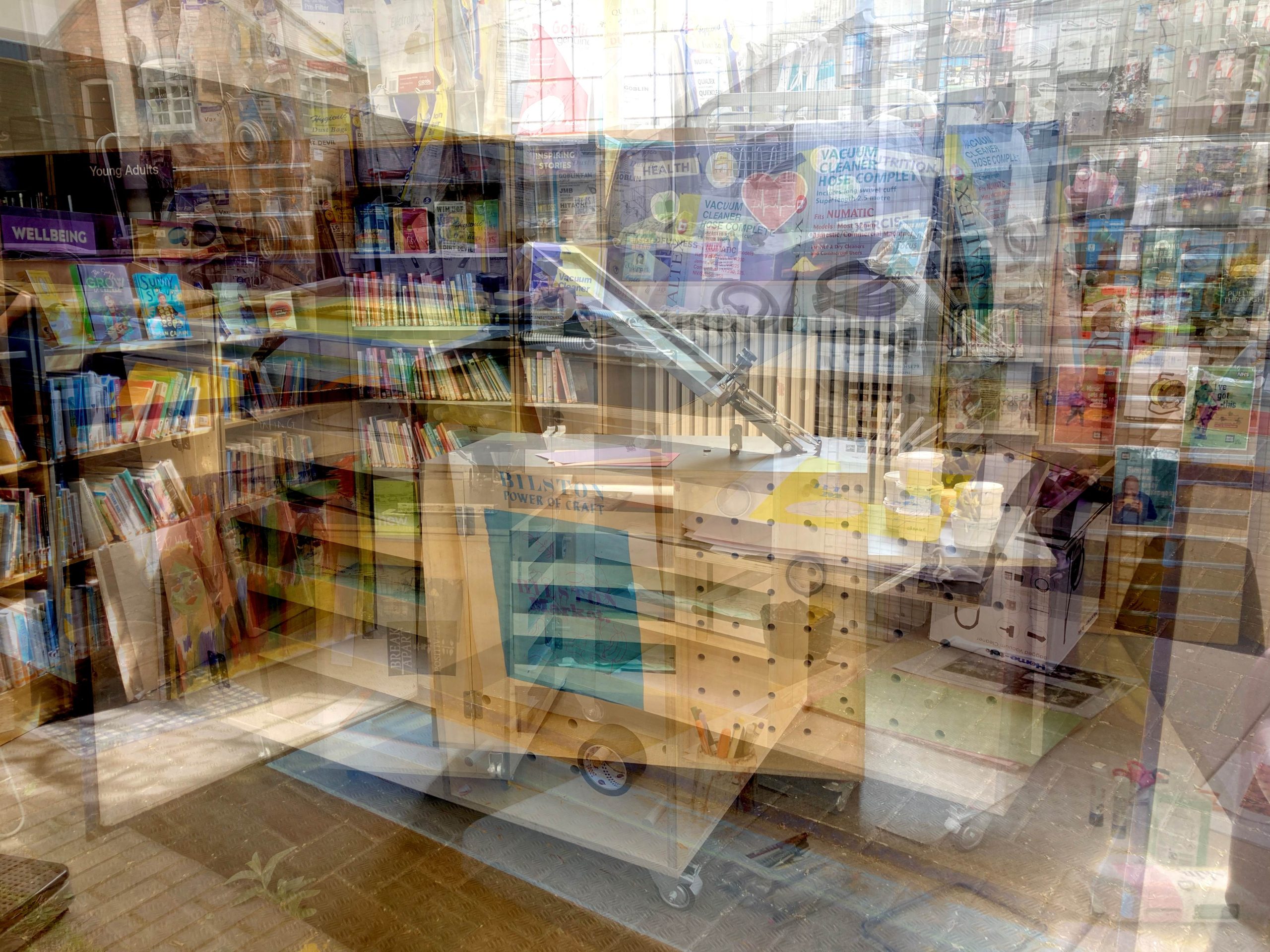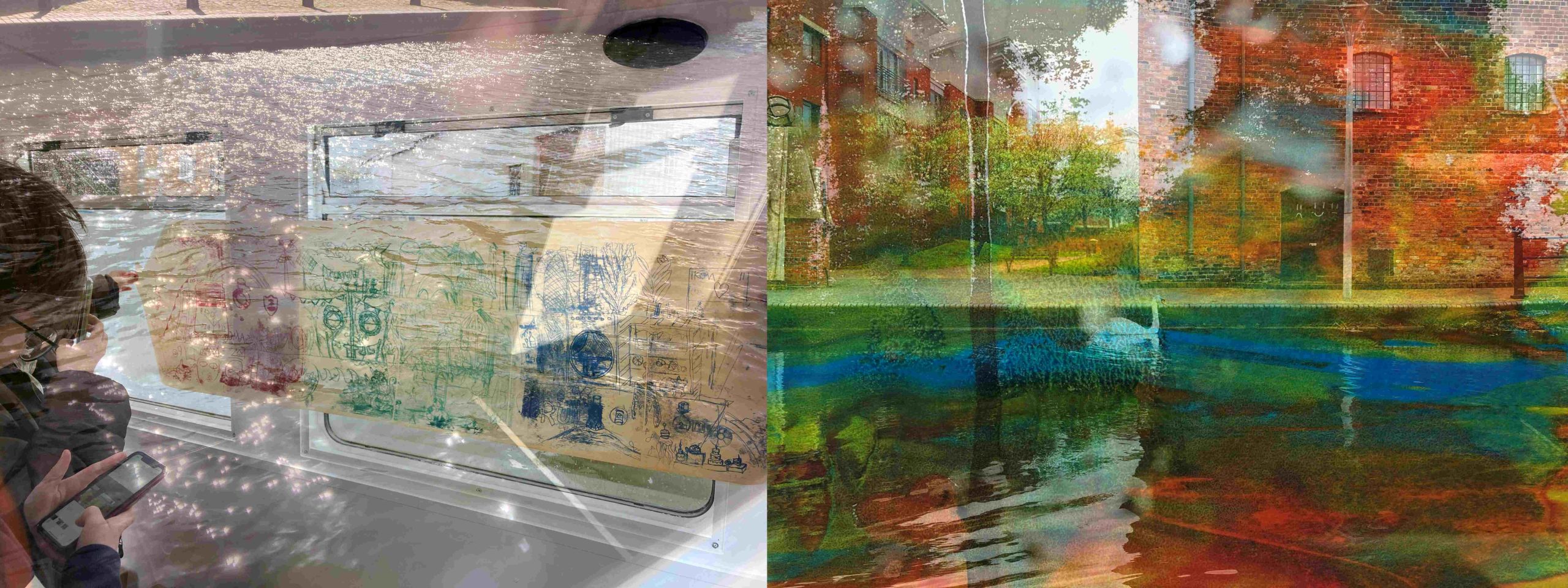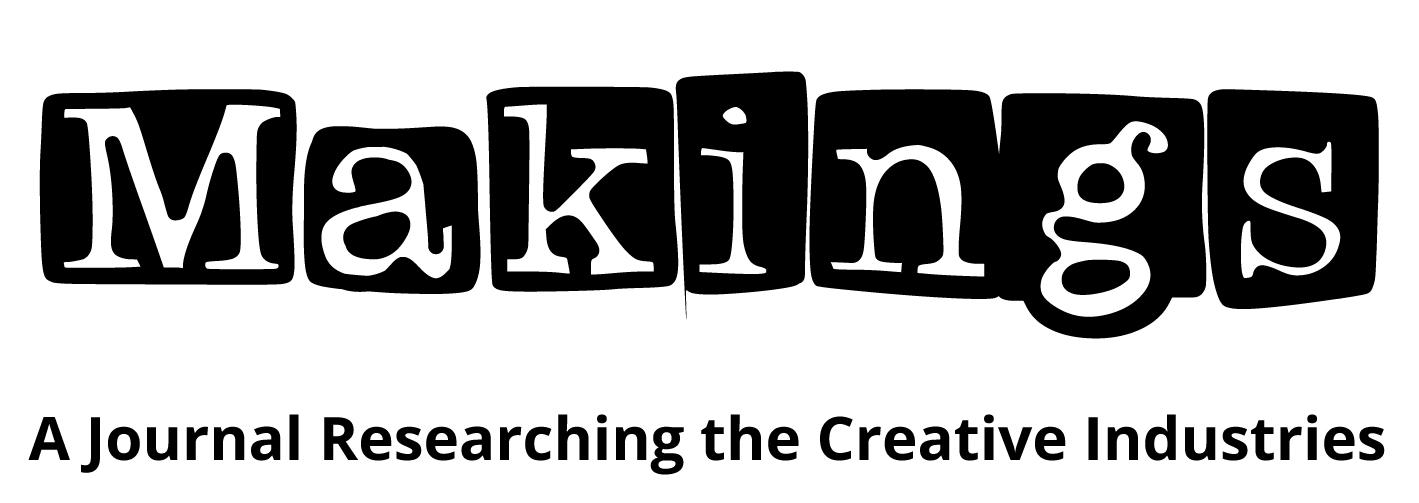
Gathering Press: Towards Environmentally Resonant Pedagogies
Laura Onions
University of Wolverhampton
Website: www.lauraonions.com
Instagram: @ljonions
Image above: Pink anemone in bloom, Dartmouth Park, West Bromwich, 4 September 2023 / Mono-screen printing using hand cut stencils, Dartmouth Park, West Bromwich, 20 September 2023.
Abstract
This practice-led paper considers the ongoing cartography and emerging pedagogies of Gathering Press, a roving screen-printing project moving within the Black Country, West Midlands, UK. The text considers the inter-relations between people, place and making, drawing upon feminist geographers and educators to explore how a resource that is unhinged from a single location can develop opportunities for community learning that are attentive to the specificities of place. From the local market and library to the canal-side, the layered and incremental moments of doing and making are embodied through a pedagogy of place and placemaking in which one scenario takes the process to somewhere else. This example mentioned initiates a discussion on the nature of the press as an object that becomes more fully itself afterwards.

Screen-printing facilities are habitually bound to institutions such as universities. These are spaces you must purposefully seek out and meet the requirements of, in order to gain access. In contrast to screen-printing’s history of collectivity and democratic making, this current access seems to me a one-sided relationship. I have been thinking about how the means of production can meet us halfway in the spaces we happen to be. How can a ‘process of making’ meet the ‘process of living’? And what kind of critical pedagogies might this propose?
In 2022, I initiated Gathering Press, a mobile screen-printing project roving the West Midlands. The press offers free workshops, that range in frequency: from drop-in activities to weekly sessions. Within a globalised educational structure, the press operates on a local model. Physically pushed between locations – the market, library, canal-side, park – it experiences the surface of space through incremental moments of doing and making. “Perhaps we could imagine space as a simultaneity of stories-so-far” (Massey, 2005, p.9) said geographer Doreen Massey in her book For Space. I have repeatedly returned to this sentence. Massey encourages thinking of space not solely as a physical locality but as a product of interrelations between people and place. ‘Stories-so-far’ implies that spatial relations are always under construction, in the process of being made, and that this making is embedded in material practices. Gathering Press emerged from this notion and led to an exploration of pedagogies of place making.
Placemaking refers to the act of creating culturally significant landscapes for and by communities (Rauscher, 2023). I am interested in how such acts of place-making through printmaking together can become environmentally resonant. In the context of this text, I initially attempted to ‘map’ these relations but fell into the mapping impulse; that of overseeing and generating pathways. In this sense, mapping as a methodology has its limitations as writer Daisy Lafarge has emphasised: “Without reflection on his/her own position within it, the act of assembling a map is akin to the assumption of a godlike perspective, above and exterior to terrestrial realms” (Lafarge, 2016). Instead, Lafarge considers the possibilities of geology and the land itself in connection with a reflective research process. Therefore, I approach these experience-research-learnings, less like a map and more like the dense and diverse layers “that stack to form something more complex than their constituent parts” (Lafarge, 2016).
In reference to this way of thinking, images from Gathering Press workshops, archival findings and images captured in place have been overlayed and stratified. These now stacked images, carried across the post-industrial landscape, enable further reflection on the ways the social and material meet in place and destabilise pedagogic positions.

May 2022
Bilston Market: Press as resource – finding its own purpose
Bilston is a town in Wolverhampton. It is an ancient settlement that developed into an industrial town ahead of its time, with coal mining dating back to the 13th century (Wolverhampton City Council, 2013, p.6). Its rich resources are found underground: a seam of coal that was once a shallow tropical sea, packed with shells and fossilised sea creatures. From the ground, mining, quarrying, and blazing furnaces produce iron and steel to the fuelling of delicate crafts, enamelling, artisanal metal work and japanning. Making is inscribed into the history of the town and its motto: ‘Bilston endures by its industry and labour.’ This situates cultural production into the specific forms of ‘human and non-human socio-material knowledges, performances, and practices’ (Page, 2020, p.63) which contribute to the way Bilston is experienced as a place.
Lak, the manager of Bilston Market reserved a prime spot for the press, sandwiched between the continuously busy café and the electrical goods shop, overlooking the outdoor market where every stall is full. Still, the purveyor of the stall next door reminisced on how the market is not what it once was. During the day, stall holders asked if the press could make something for their stalls. ‘For sale’ signs, posters and even a birthday card, the agenda led by the market. A garment seller wanted to highlight the origins of the dresses on offer. We worked to make a sign that could shine brightly on the stall, that read ‘Made in Italy’.
As a local resident and visitor to Bilston market, it was a new experience to be working there through Gathering Press, a space of familiarity becoming unfamiliar. There is a certain vulnerability in moving outside of prescribed spaces of teaching and learning, of being dislocated. In Teaching Community, a Pedagogy of Hope, bell hooks writes of the ‘strange and threatening landscape’ that comes with occupying a different standpoint from what is usual to us – yet this is a space in which it is possible to make critical interventions, as hooks states; “dislocation is the perfect context for free-flowing thought that lets us move beyond the restricted confines of a familiar social order” (hooks, 2003, p.21). Using this conception, the press acts as an intermediary towards learning new place-making practices. hooks explains how a personal sense of place-belonging is enabled through a physical practice, “I need to live where I can walk…Walking, I will establish my presence” (hooks, 2009, p.2). Similarly, the practice of printmaking enabled a personal revisiting of the market, a kind of pedagogy understood as an entanglement of the body with the world.

Library & Craft Gallery: Press as Storytelling
It was a 10-minute walk pushing the press from the market to the library, which doubles up as a craft gallery, on the other side of Bilston. Here the press was surrounded by cabinets exhibiting fossils and enamel wares – artefacts from Bilston’s industrial and creative histories. It was a quiet space for a workshop. One participant, Lynn, worked in the Bilston enamel factories and another, Stephen, in the forges producing metal and steel. Stephen marvelled at the collection of paintings by Edward Butler Bayliss that adorned the walls. Views of the Black Country landscape of the 1800-1900s; billowing smoke, heavily polluted atmosphere with bright orange glows of molten metal and flames. These chimed with his more recent experiences, recalling his labour, the mechanics, the danger within the process and the damage done to the environment. He decided to make a print based on this. We worked together to create backgrounds of red and yellow that melded into fiery orange.

November 2022
Social Prescribing: Press as social wellbeing
The first time Gathering Press was used by a returning group of people was when I was invited to lead a programme of weekly workshops with Alex and Gary from RAW (Real Arts Workshops) for Wolverhampton Social Prescribing. The group was formed of 8 participants, each of whom were referred to the workshops for physical, mental health and wellbeing needs. The workshops incrementally encouraged dialogue, framed by sharing experiences of local green spaces and environments that feel restorative. Printmaking in this context became an agent to translate experiences and build relationships.

A photograph of an acer tree changing colour, images of thistles and falling poppies. A photo of a row of houses and an image of the green square in central Wolverhampton; participant photographs and handwritten notes ‘Trees communicate – they warn each other about danger’ were exposed on to the screens. The capacity to print directly from personal imagery initiated a process of re-valuing place, through the repetitiveness of screen-printing manoeuvres but also the conversations that arose. Dialogue questioned the use of spaces in the city and how they change, things that were once there but are now lost, housing and public space – an examination of the inequalities of place, “we are a complex materiality of bodies, immersed in social relations of power” (Page, 2022, p.123) through making and remaking images individually and collectively, the group could find new perspectives on the everyday.

The time afforded through the programme enabled the group to develop an embodied relationship to the press itself. Noticing small technical competencies such as changing the screen on the arm and registering paper or feeling confident to open the cupboard to find the right colour ink or rummaging through the shelves for paper and prints, indicated how the group had taken ownership of the press as a resource. The character of the space also transitioned, from general meeting space to that of a workshop, and to borrow from researcher D-M Withers who researched the role of the print workshop in 1970s and 1980s women’s movements, the workshop acts as a “social-pedagogic time/space” in which exclusion could be tackled and self-actualisation could be nurtured (Withers, 2020, p227).

April 2023
Canal: Press as responsiveness to place
Nothing was audible through the loud rumble of wheels over cobble stones as I pushed the press with Dee and Rosie towards the Canalside, the reverberation shaking our bones. We hauled the press onto the Ikon Slow Boat[1], a converted narrow boat temporarily moored in Wolverhampton. With the Ikon Youth Programme[2] group on board, we set off for a journey along the canal. The group explored mono-printing techniques, a spontaneous approach with a painterly gesture. Occasionally, we would lose light as the boat went through a tunnel, pausing activity momentarily. Tow paths, wildlife, graffiti, buddleia, and industrial sites passed by and re-emerged in the resulting prints. Some imagined what lurked beneath the waters.

In operating across multiple locations, being between spaces, there is a bodily ‘withness’ that dissolves conventional teacher-learner identities, instead becoming jointly responsible for learning together.
“To know, understand and learn the placemaking practices that are often invisible, hidden and mostly taken for granted (because they are of the body and not easily verbalised), an embodied, affective and relational approach is needed” (Page, 2022, p.123)
The mobile nature of the press shapes its relational approach. In travelling from one place to another, it could be thought of as a ‘boundary object’ an artefact of practice that is shared between different domains yet is able to represent each domain and associated knowledges individually (Star, 2010). From the press as a resource that found its own purpose, a story-telling device, or a tool for collective wellbeing, each of these experiences mirrors the premise of place and of landscape; layered, ongoing and unfixed which results in a pedagogy of placemaking which is equally malleable and environmentally resonant.
[1] Ikon Slow Boat (2011 – present) is a programme by Ikon Gallery on a converted canal boat. Involving the Ikon Youth Programme, the boat is a site for exhibitions, performances, workshops, screenings, talks and activities.
[2] Ikon Youth Programme are a group of young people aged 16 – 21 who meet to make, think, and explore aspects of contemporary art and education in connection with Ikon Gallery’s wider programme.
Thanks to Kirsty Clarke for supporting the inaugural outing with the press in Bilston, May 2022. Your skills and companionship have been invaluable.
About the author
Laura Onions (she/her) is a Black Country based artist and senior lecturer in Fine Art at the University of Wolverhampton. Her printmaking practice adopts sculptural and social forms to share spaces for learning, often specific to localised contexts. Since 2022 she has been co-director of Eagle Works Studios in Wolverhampton.
References
Hackney, F., et al. (2022) ‘Maker-centricity and ‘edge-places of creativity’: CARE-full making in a CARE-less world’, in European Journal of Cultural Studies, vol. 25(6) pp. 1572 – 1596.
hooks, b. (2003) Teaching Community, a Pedagogy of Hope. Routledge: New York.
hooks, b. (2009) Belonging: A Culture of Place. Routledge: New York.
Lafarge, D. (2016) ‘Footnoting the Archive: Speaking Nearby’, MAP Magazine. Available at: https://mapmagazine.co.uk/daisy-lafarge (Accessed: 18 Jan 2024).
Massey, D. (2005) For Space. SAGE Publications Ltd: London.
Morton, T. (2010) The Ecological Thought, Harvard University Press: USA.
Page, T. (2020) Placemaking, A New Materialist Theory of Pedagogy. Edinburgh University Press: Edinburgh.
Rauscher, J. (2023) Ecopoetic Place-Making. Verlag: Bielefeld.
Stacey, J., Woolf, J. (2016) Writing Otherwise: Experiments in Cultural Criticism. Manchester University Press: Manchester.
Star, S.L. (2010) ‘This is Not a Boundary Object: Reflections on the Origin of a Concept’ in Science Technology & Human Values, vol.35(5), pp. 601-617.
Withers, D-M. (2019) ‘The Politics of the workshop: craft, autonomy and women’s liberation,’ in Feminist Theory, vol.21(2), pp. 217 – 234.
Wolverhampton City Council (2013) Bilston Town Center Conservation Area Appraisal and Management Proposals. Available at: https://www.wolverhampton.gov.uk/sites/default/files/pdf/Bilston_Town_Centre_Appraisal.pdf (Accessed: 2 Feb 2024).
